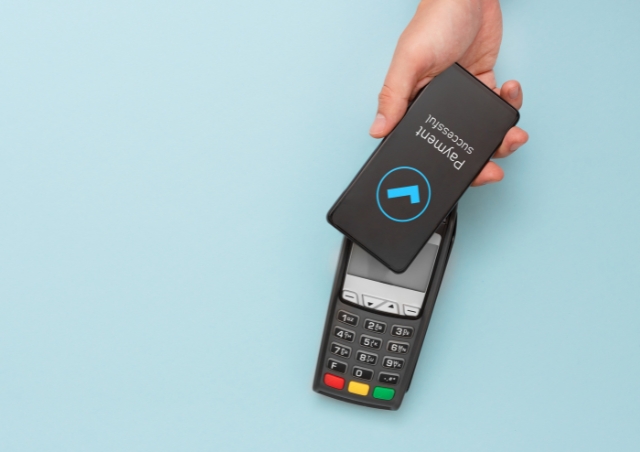As technology continues to evolve, so does the world of payments. However, the shift to digital payments didn’t start with COVID-19. While the pandemic has accelerated the transition to online payments due to (mostly) their convenience and hygiene benefits, the roots of electronic payments can be traced back to 1871. However, it wasn’t until 1994 that the world witnessed the first financial institution (Standford Federal Credit Union) launching its online banking services for all its clients. It’s fascinating to think about how much progress we’ve made in 30 years. If you’re interested to explore the history of online payments, you can found one here.
Digital Payments of Today and Tomorrow
In this blog post I will explore five exciting trends and innovations that have shaped, and will most likely continue to shape, the future of digital payments in the banking industry.
Contactless Payments
The evolution of contactless payments has gained immense momentum since COVID-19. It offers an extremely convenient and rapid way to make purchases without the need of handling physical money, thereby making it also very hygienic. By just tapping your mobile device or even your smartwatch, you can complete a purchase! This technology utilised what is called NFC (Near Field Communication) technology which allows data to be transferred when a card, mobile device or smartwatch is brought near a compatible point-of-sale terminal.
While the traditional contactless payments were designed with in-person retail transactions in mind, these have evolved and go beyond payments at brick-and-mortal stores. E-commerce websites and mobile apps are now integrating with digital wallets, enabling customers to make payments with a single tap instead of entering their card details during their shopping experience.
As technology continues to advance, the future of banking is undoubtedly contactless, pushing this convenient payment method to become even more integrated in our daily lives. Embracing this trend is key for the banking industry to survive and maintain a competitive edge in this digital era.
Peer-to-Peer (P2P) Payments
Peer-to-Peer payments represent another evolution in digital payments over the past couple of years. While P2P are sometimes put under the same umbrella as contactless payments, they are distinct concepts. P2P is mostly targeted for person-to-person or person-to-business transactions while contactless payments are primarily designed to provide a faster and more convenient payment checkout experience.
The convenience of settling your share of bill with friends by simply entering their number into your mobile app is quite evident. This convenience, combined with the integration of Peer-to-Peer payments into popular, easy-to-navigate mobile apps has pushed the use of this payment method exponentially in recent years.
Cryptocurrencies and Central Bank Digital Currencies (CBDC)
Cryptocurrencies and CBDCs are both forms of digital money, meaning that they exist solely in electronic format, without any physical coins or banknotes. Both currencies enable faster transactions, especially for cross-border transactions, in contrast to traditional payment methods. Additionally, they reduce the number of intermediaries, thus simplifying financial interactions during payment processing, resulting in reducing overall transaction costs.
Despite their similarities, they differ in several ways. For example, cryptocurrencies are typically decentralised, operating on a blockchain network, while CBDCs are usually centralised and backed (and regulated) by banks. The public perception of both also varies. While cryptocurrencies are usually considered as alternative investments, CBDCs are treated the same way as traditional banknotes, albeit in digital form. This means that using CBDCs doesn’t mean owning a separate asset unlike the perception when owing cryptocurrencies.
Biometric Authentication
Digital payments are only successful if people trust that their data is safe throughout the entire payment ecosystem, making security a top priority in the world of digital banking.
Several security mechanisms have been introduced during the past years, with biometric authentication experiencing exponential growth. Whether making payments through fingerprint and/or facial recognition, the convenience of not having to remember, store and enter a PIN to make use of a digital payment is evident. Furthermore, these authentication mechanisms significantly reduce fraud such as identity theft or unauthorised access to accounts.
Open Banking
Open Banking is basically a mechanism where consumers grant their consent to banks to share their personal and financial details with third parties through what are known as APIs (Application Programming Interfaces). These third-party providers (TPPs) act as intermediaries between consumers and banks, offering value-added services that are not traditionally offered through the bank’s online channels. Consequently, they are motivated to create innovative solutions, including integrations with other systems and services that may not be directly related to the banking industry, in order to attract more customers.
With the introduction of the Second Payment Services Directive (PSD2), Open Banking has become regulated in the UK and European Union. The primary goal of this regulation is to promote competition, empower consumers, and enhance security.
In an era of rapid technological evolution where customer-centricity is being placed at the epicentre of organisations, the future of finance looks very exciting. The transformation in payments isn’t just about the way of doing transactions, but rather about the entire experience. Biometric Authentication will continue to gain momentum, with the potential for more investment in voice recognition and iris scanning (i.e. through unique eye patterns). With the EU exploring the introduction of the Digital Euro, CBDCs will undoubtedly grow. These developments underscores that we’re living in a financial landscape where boundaries are constantly expanding, and the possibilities are boundless!
I’m Jonathan Spiteri, and I bring a wealth of experience in innovation, strategy, agile methodologies, and project portfolio management. Throughout my career, I’ve had the privilege of working with diverse teams and organisations, helping them navigate the ever-evolving landscape of business and technology. I’ve also earned multiple prestigious certifications, such as Axelos Portfolio Director, SAFe® 6 Practice Consultant, Organisation Transformation, Project Management Professional (PMP), TOGAF 9.2, and Six Sigma Black Belt. These qualifications reflect my dedication to achieving excellence and my proficiency across various domains.


